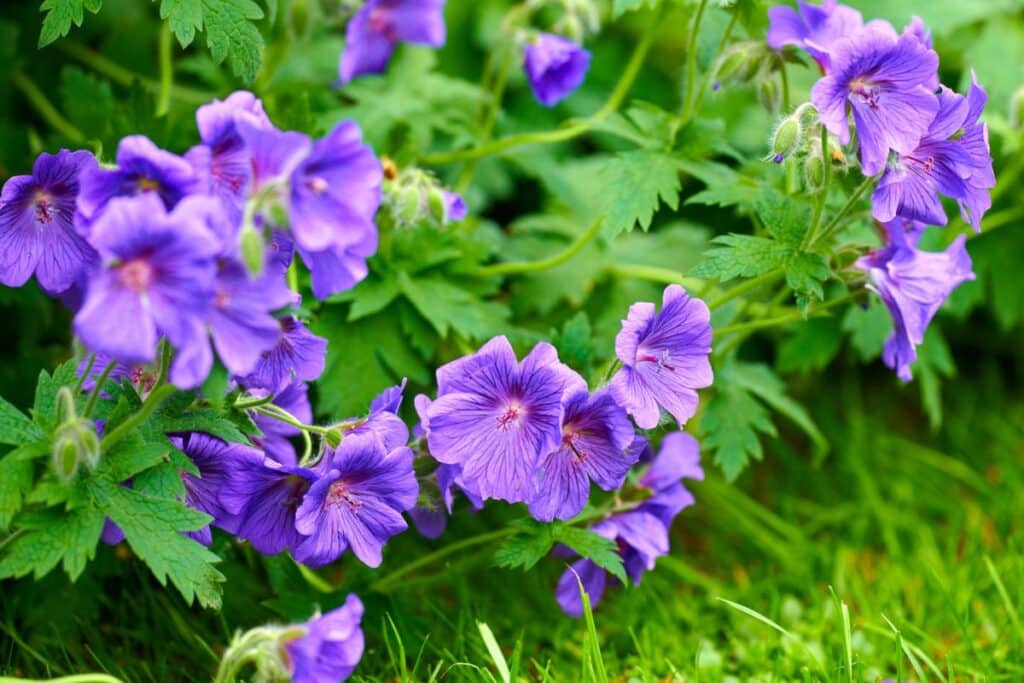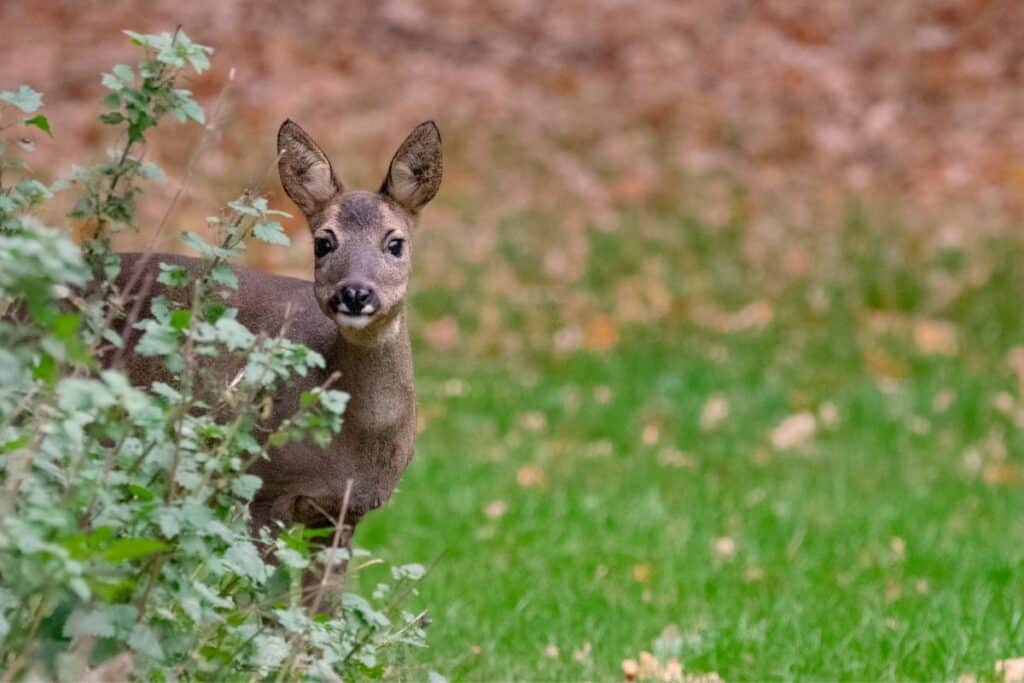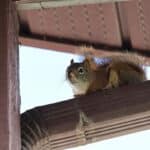Geraniums make a great addition to your garden, adding color and gorgeous smells. When you put in the hard work to grow them, it can be disheartening when something starts eating them.
Deer eat geraniums when their usual food sources are not available. Geraniums will not be the first option as deer do not particularly enjoy the plant’s texture, smell, or taste. Several deterrence methods will allow you to keep the deer from eating your plants.
This article clarifies why deer might even consider geraniums as food and makes the information more relevant to areas with a high deer population.
What Animal is Eating My Geraniums?
It may be challenging to identify what it is when you don’t see the animal eating your geraniums. Key indicators will allow you to deduce which type of animal is wreaking havoc.
First, examine the way the plants are being eaten. Deer have no qualms about shredding your plants while they eat them. A smaller animal, like a rabbit, will be more delicate about eating.
Second, you’ll want to look for droppings. If it’s a deer, you’ll immediately recognize the larger, marble-sized droppings characteristic of deer.
Third, deer have very characteristic hoofprints. Wherever they step and can leave an impression, they leave a heart-shaped mark on the ground.
Finally, you probably have a deer problem if you notice massive garden areas lying flat. Due to their large size and weight, they can cause significant damage to your plants just by walking through them.
Are Geraniums Deer Resistant plants?
As a general rule, deer do not eat geraniums. However, in situations of desperation when their primary food sources are not available, they will eat almost anything in front of them, including your beloved geraniums.
Many types of geraniums have a fuzzy texture and a strong fragrance. The combination typically deters deer. However, if there is nothing else to eat or other plants attractive to the deer are nearby, your geraniums could end up on the menu.

Do Deer Eat Geranium Blooms?
Deer will eat geranium blooms as a last resort. Often, they do it because there is not enough of their preferred food to fill them up. Again, if you have deer-friendly plants nearby, the deer may continue eating, including your geraniums.
What Naturally Keeps Deer Away from Plants?
If you’d instead take the all-natural route to deter deer, there are several types of companion plants you can place around your geraniums and other deer-favorite flowers. There are herbs, bristly shrubs, and flowers deer cannot stand.
Despite the deer’s dislike of these plants and their bitter taste, they are vulnerable for the first few weeks after being planted. You may need to spray them with deer repellent to prevent them from being eaten while they are trying to grow.
Use Resistant Herbs
Deer tend to dislike plants with fragrant scents. These include a wide variety of herbs, among other deer resistance plants. One of the additional benefits for you is the unique scent combinations you can create in your garden.
You can plant the following as companion plants with your annual geraniums:
- Lavender
- Sage
- Yarrow
- Monkshood
- Mint
- Basil
- Rosemary
- Horseradish
- Wild ginger
- Asparagus
- Common boxwood
- Wood fern
- Catmint
- Thyme
- Yucca
- Chives
It’s also helpful to learn about what not to plant with geraniums in your garden.
Plant Bristly Shrubs
Deer avoid bristly shrubs because they are challenging to eat. Occasionally, as with many types of rose bushes, the deer will learn to eat around the bristles to obtain sustenance. Plants with spiny leaves are typically avoided as they are a complete turn-off.
Examples of these deer proof plants include bear’s breeches, sea hollies, and globe thistles.
Grow Flowers Deer Dislike
You can also deter deer by using several different deer resistant flowers. They particularly avoid plants with fuzzy or hairy foliage and highly fragrant plants. Several of these plants also exhibit toxicity for the deer, increasing their avoidance of the area.
By choosing some of these excellent companion plants, you’ll be sure to deter the deer that want to eat your geraniums. The deer will keep moving and only eat your plants if they are desperate.
There are also deer resistant plants like flowers that work well to keep deer away include the following options for your flower beds:
- Bleeding heart
- Juniper
- Arrowwood viburnum
- Daffodils
- Andromeda
- Bluebeard
- Russian sage
- Peonies
- Lamb’s ear
- Butterfly bush
- Hostas
- Tulips
- Foxgloves
- Shrub roses
- Bayberry
- Poppies
- Cranesbills
- Daphne
- Irises
- Yarrow
- Bee balm
What Can I Put Around My Plants to Keep Deer From Eating Them?
When companion plants aren’t enough, you may need to try something slightly more extreme. Several tactics are recommended to keep deer from getting into your plants, from using chemicals to putting up a fence.
Use a Spray
As I mentioned, deer are sensitive to smells and dislike strong-smelling things. You can use sprays to help deter them. You can make your own homemade from a combination of ingredients such as milk, eggs, dish soap, hot peppers, and water.
It’s recommended that you let the mixture stew in the sun to allow it to be pungent when you finally do spray it. Spraying at night will allow you the luxury of not having to smell it when it’s at its most potent scent during the day.
If you’re not comfortable making your own repellent because of the process or the potential smell, commercially prepared options are available.
Put Up a Fence
While this option isn’t for everyone, it is still viable. Putting up a fence is an excellent method of deterring deer from entering your yard and preventing deer damage to your precious plants. Many homeowners don’t like the idea because of the aesthetics and the cost.
Wire mesh fencing is the most popular type available and can be purchased in a nearly invisible format called polypropylene. With this style of fence, you won’t have to worry as much about how the fence looks as it is not as visible.
Electric fencing is also an option, drawing the deer to a specific location and giving it a slight shock. However, it’s not a barrier and is, instead, a behavioral modification device to train the deer to stay out of your yard.
Many people disagree with using an electric fence for any animal and believe it is inhumane.
If you’ve been interested in adding a little more seclusion to your yard, a privacy fence can provide that and keep the deer away. You can pick a stylish model so you won’t have to worry about the appearance.
Try Commercial Deer Repellents
Commercial deer repellents come in various forms. If you don’t want to deal with the smell constantly, you can opt for a model that sprays when the deer comes close to the flowers.
It will offer a jet of repellent, and if the deer is still within range a few seconds later, it will do it again.
Other options will have to be sprayed directly on the area you want the deer to stay away from. These sprays can leave a white residue on the plants and have a powerful odor that may also be bothersome to you.
Some repellents don’t use scent. They work by flashing a light whenever the deer gets close to the plants. The light will scare the animal away before it has a chance to eat your plants.
Use a Sprinkler
You can set up a sprinkler in your yard, but make it even more improved by adding a motion detector. When a deer comes into your yard, it will get sprayed by the water. The shock of the water turning on should be enough to send the deer packing.
This method can provide multiple benefits: your plants will get water without doing anything, you won’t have to smell any stinky sprays you create or buy, and the deer won’t eat your plants.
Enlist Fido
If you have a dog, keep him in the yard as much as possible. This will make your yard less inviting to a hungry deer. If you can, collect some of his fur and sprinkle it around the garden to help reinforce the idea that there is a dog there and the deer is not welcome.
The goal is to make your yard smell as much like your dog as possible so that the deer will still catch his scent when he is not outside. Because of the predator-prey relationship, the deer will not likely stick around.
Playtime with Fido can achieve more than just burning off his excess energy. It can help deter your troublesome deer, giving your geraniums and other plants a chance at a long life.
Add Levels or Slopes to Make the Yard Harder to Traverse
Changing the landscape is one of the most challenging options to make your yard less deer-friendly. You can add additional levels, steps, or slopes to make your yard harder to walk across.
This also may be beyond your scope of abilities. You may need to hire a professional landscaper to redo your entire yard. They’ll have expert equipment and the ability to move more earth than you.
The only issue you might have with this method of deterrence is that it will be harder for you to traverse your lawn. You’ll have to decide if you want to put in the time and effort to make the changes and if you are comfortable with the results.
What Other Pests Might Be Bothering Your Geraniums?
Deer are not the only animals that may be eating your geraniums. In addition to animals, many smaller pests can be feasting on your plants.
Rabbits, like deer, eat geraniums when other food sources are unavailable. They don’t generally like the texture of the leaves, but the flowering plant will do in a pinch.
Rats are a significant pest for geraniums. They can completely destroy the blossoms by eating all the buds. You must act quickly to save your geraniums if you think you have a rat problem.
Birds, especially hummingbirds, are attracted to the geranium’s flowers. They get vital nutrients from the nectar in the flowers.
Javelinas are another opportunistic animal that will eat geraniums when there isn’t much else available. This isn’t their first choice, but it is a way for them to get food when needed.
In addition to animals, several insects feast on geraniums. The primary offender is the geranium budworm which eats the buds and chews holes in the leaves. These caterpillars are the larvae of the owlet moth.
The moth lays her eggs on the geraniums, and then when they hatch, they immediately begin consuming the flowers.
Aphids are another insect pest. They feed on the geranium leaves and curl them up to hide inside them. They can cause significant damage to your plant as they suck the sap out of it, which leads to stunted growth.
An interesting pest is the Japanese beetle. Yes, they eat the leaves; however, the result is paralysis caused by the plant. Despite this side effect, you can still end up with a massive infestation that requires fast treatment.
Grasshoppers and locusts are also known for eating geraniums. They are rapid multipliers that feed a lot. The damage can be extensive if it’s not caught early on.
Final Thoughts
When growing geraniums, while these plants are pretty hardy, they’re still subject to various pest problems. This can be frustrating as your beautiful blooms can be destroyed in one night. You will have to act quickly to prevent severe damage to your geraniums at the first sign of a pest problem.
Deer do not typically eat geraniums but will if there is no other option. You can take several steps to prevent them from destroying your plants, including adding companion plants, making the yard smell like your dog, adding a motion detector system, and spraying repellent.
In addition to deer, a whole host of animals and insects are pests when it comes down to eating your geraniums. Rats, aphids, and geranium budworms are the worst of all the pests concerning damage caused. If you catch the problem early enough, you can save your geraniums.
See more:
*image by [email protected]&PeopleImages.com/depositphotos







